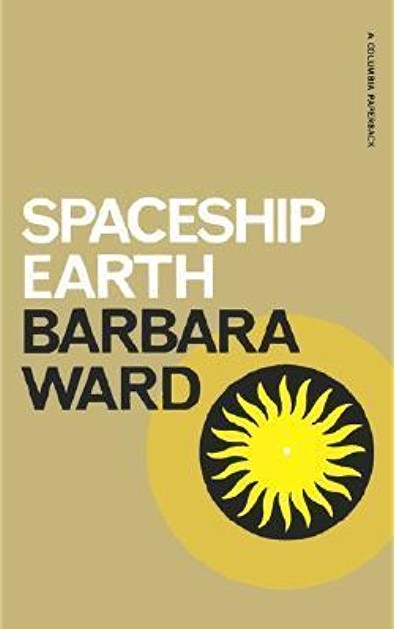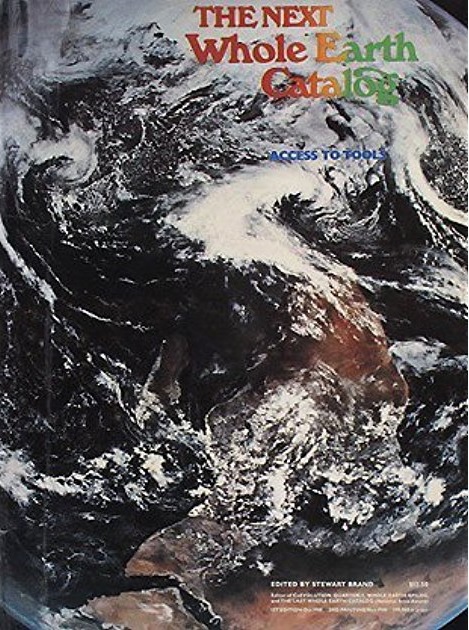

Go to Whole Earth Collection Index
by Stewart Brand
Originally published in The Essential Whole Earth Catalog, 1986
THE WHOLE EARTH CATALOG got started in a plane over Nebraska in March 1968. The sun had set ahead of the plane while I sat reading Spaceship Earth by Barbara Ward. Between chapters, I gazed out the window into dark nothing and slipped into a reverie about how I could help my friends who were starting their own civilization hither and yon in the sticks. The L. L. Bean Catalog of outdoor stuff (p. 274) came to mind, and I pondered upon Mr. Bean's service to humanity over the years. So many of the problems I could identify came down to a matter of access: Where to buy a windmill. Where to get good information on beekeeping. Where to lay hands on a computer.
Shortly, I was fantasizing access service. A truck store, maybe, traveling around with information and samples of what was worth getting and information on where to get it. A catalog, continuously updated, in part by the users. A catalog that owed nothing to the suppliers and everything to the users. It would be something I could put some years into.
Amid the fever I was in by this time, I remembered R. Buckminster Fuller's admonition that you have about ten minutes to act on an idea before it recedes back into dreamland, so I started writing on the end papers of Barbara Ward's book (never did finish reading it).
One of the main things that drove me into business was ignorance. A liberally educated young man, I hadn't the faintest idea how the world worked. Bargaining, distribution, mark-up, profit, bankrupcy, lease, invoice, fiscal year, inventory - they were all a mystery to me and were usually depicted as sordid. I noticed that great lengths were gone to in order to prevent "consumers" from knowing that part of the purchase price went to the retailer. It seemed exquisitely insane to me. You sell deception and buy mistrust to no advantage. The retailer in fact earns his 25-40 percent by tiresome work, but the prevailing attitude makes him out a clever crook. Ignorance institutionalized. Would you mind leaving the room? We're talking about money.
At the time, in fact, finances were not particularly on my mind. How to Make Money was not the design problem. (I'd heard and bought Ken Kesey's advice that you don't make money by making money: you have that in mind early on, but then you forget it and concentrate entirely on good product; the money comes to pass.) The problem was How to Generate a Low-Maintenance, High-Yield, Self-Sustaining, Critical Information Service.
Easy. You name what you know is good stuff and indicate exactly where to get it. You do this on newsprint, which costs half of the next-higher paper stock. Low overhead at every step. Employ stone amateurs with energy and enthusiasm. Build furniture out of scrap doors, light tables out of scrap plywood, work in whatever space you have. Pay your pros $5/hour (no raises) and the beginners $2/hour with $.25/hour raises every couple months. Employees fill out their own time sheets. If they get dishonest about that - or anything that hurts service - fire them. Spread responsibility as far as it will go, credit too.
What you're trying to do is to nourish and design an organism that can learn and stay alive while it's learning. Once that process hits its stride, don't tinker with it; work for it, let it work for you. Make interesting demands on each other.
By June 1969, we were being mentioned in a lot of underground papers such as the East Village Other. And then Nicholas von Hoffman wrote a full piece on the Whole Earth Catalog that got syndicated all over the US. We were caught. We were famous.

Of all the press notices we eventually got, from Time and Vogue to Hotcha! in Germany to a big article in Esquire, nothing had the business impact of one tiny mention in "Uncle Ben Sez" in the Detroit Free Press, where some reader asked, "how do we start a farm?" and Uncle Ben printed our address. We got hundreds and hundreds of subscriptions from that.
We hired more people. Deposits at the bank were more frequent. The bank officers got more polite.
In September 1969, as I was driving up the hill to work, it suddenly hit me that I didn't want to. Instead of a golden opportunity, the publication was becoming a grim chore. I considered the alternatives of taking my medicine like a good boy or setting about passing my job to somebody else. I'm sure I sighed unhappily. And then this other notion glimmered. Keep the job, finish the original assignment, and then stop. Stop a success, and see what happens. Experiment going as well as coming. We printed in the Septmeber 1969 Supplement that we would cease publication with a big Catalog, The Last Whole Earth Catalog, in Spring of 1971.
Meanwhile, business was still growing. The morning mail was a daily, heavy Santa Claus bag.
Our stopping was primarily an economic experiment. Rather than do the usual succession things, we preferred to just cease supply and let demand create its own new sources. Our hope was that those sources would be more diverse and better than we had been or could have been if we had continued.
So, in June 1971, we had the Demise Party celebrating the self-termination of the Whole Earth Catalog, and all in all it was a rout. Fifteen hundred people showed up. San Francisco's Exploratorium staff had their museum weirding around us full steam. At midnight, Scott Beach announced from the stage that these here two hundred $100 bills, yes, $20,000, were now the property of the party-goers, just as soon as they could decide what to do with them.
"Flush them down the toilet!" "No, don't!" "Give it to the Indians!" "Bangladesh!" "Our commune needs a pump or we'll all get hepatitis!" And so on. The debate lasted till nine o'clock the next morning, when a dozen remaining hardcore party-goers turned the remaining $15,000 ($5,000 had been distributed to the crowd at one wild point) over to Fred Moore, dishwasher. He later gathered people for other group decidings over what to do with the money. That worked out damn well. Most of the story, Rolling Stone's account, is in The Seven Laws of Money...
My reasons for perpetrating? Pure curiosity. Some of the surprises were: 1) the money kept trying to come back - innumerable suggestions involved the Portola Institute (Whole Earth's fiscal agency) as the recipient; 2) Handling of more than a pocketful of power was new to most, upsetting, educational; 3) Ideas were mostly busy - unoriginal, guilt-ridden; 4) People who focused on the process of deciding had a much better time than those who focused on the money; 5) "Free money" is crazy.
In 1971 we had ceased making Whole Earth Catalogs forever, sincerely expecting that someone would quickly come along and fill the niche better than we did. Well, they didn't. The Last Whole Earth Catalog won the National Book Award in 1972 and continued to sell 5,000 copies a week with increasingly outdated information. We updated it in 1973 and 1975 and added what amounted to Volume II in 1974: The Whole Earth Epilog. Then the North American economy began to lose its mind, putting more people in need of tools for independence and the economy as a whole in need of greater local resilience.

After burning our bridges, we reported before the Throne to announce,"We're here for our next terrific idea." The Throne said, "That Was It."
"It" became a journal called the CoEvolution Quarterly (CQ). I had been wanting to call it "The Never Piss Against The Wind Newsletter," or perhaps "Making Circuit." I did have a formula in mind: we would print long technical pieces on whatever interested us - the opposite of the predigested pap in, say, Intellectual Digest. So the Spring 1974 CQ had Paul Erlich on coevolution, Roy Rappoport and Howard Odum on energy and culture, Sam Keen on spiritual tyranny, and a nice reception from readers. We had printed 5,000 copies of the 96-page Spring CQ and sold them all. The Summer CQ sold out 10,000 copies immediately; we had another 7,000 printed.
By winter 1979, we had put out 24 issues of CQ. For years, we resisted the standing temptation to do a new version of the Catalog because of the sheer labor involved. Then Art Kleiner, a University of California/Berkeley journalism graduate, indicated that he would like to work with us.
In the brutal/apologetic tones you would use asking someone to scrub the toilets, I said, "Art, how would you like to handle the compiling of a new Whole Earth Catalog? That includes working on the distribution deal and production and printing, as well as contacting all of the old listees for their recent information and making final sense out of the doubtless-conflicting evaluation messages from the editors."
"Sure," he said.
If Art was that brave, I guessed we could be. Then began the sift through everything in the Whole Earth Catalog, the Whole Earth Epilog, and 24 issues of CoEvolution Quarterly to identify, update, and assemble the best. New prices, new addresses, new covers, new excerpts (from catalogs and magazines), and other new reviews.
Called The Next Whole Earth Catalog, it had 608 folio-size pages, reviewed 3,907 items and weighed 5½ pounds. Before the ink was dry on the first 1980 edition, work began on a second edition that appeared in 1981.
All told, more than 2.5 million Whole Earth Catalogs have been sold since we started in 1968, and that doesn't count the Whole Earth Software Catalogs of 1985 and 1986 or the Catalog you're presently holding. There's more on the way.